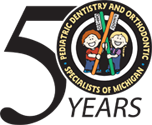Cracked tooth syndrome, or a fractured tooth, is prevalent and a challenge to dentists because it can be very hard for a patient and even the dentist to see or find. We always consider it as a possibility when a patient comes to us with a toothache.
Does your child seem to have a bizarre toothache that comes and goes? Sometimes he’s fine when drinking soup, and sometimes he flinches so hard at the pain he spills his food. These are signs and symptoms that make dentists think there may be a crack in a tooth. This is especially true if your child may have injured his teeth in sports, biting too hard on something, or from bruxism (teeth grinding).
Early diagnosis and treatment leads to successful dental management and a good prognosis for that tooth. By catching these issues early, we hope to avoid any worsening of the fracture. Fractures that progress under the gumline or into the nerve (pulp) greatly decrease the prognosis for the affected tooth.
Types of Tooth Fractures
Craze lines
These are small cracks on the outer enamel of the teeth. Craze lines don’t typically require treatment and are typically incidental findings. If they are generalized through the mouth, they can indicated a grinding habit.
Cracked teeth
Here, the tooth is truly cracked from chewing surface through the enamel, but the tooth isn’t split yet. A crack that has reached the pulp would be really painful and would be fixed with a root canal.
Split tooth
A cracked tooth becomes a split tooth if left untreated. Here, the crack becomes long enough to completely split the tooth in two. This tooth can often no longer be saved, though a portion might be saved with a root canal.
Fractured cusps
The cusp is the chewing surface of the tooth. Here, a piece of the cusp chips off. Fractured cusps are surface injuries like craze lines and are not painful, though sharp edges can cause injury to the tongue or cheek. We fix this relatively simply with a composite filling or crown.
Vertical root fractures
These are the cracks that occur beneath the teeth, starting at the root of the tooth rather than the chewing surface. This typically requires that the tooth be removed but there is an outside chance that a root canal (endodontic treatment) can allow the tooth to be saved.
Symptoms
Cracked tooth diagnosis can be tricky because the symptoms are similar to what your child may experience in sinusitis, TMJ, really bad headaches and symptoms from a cavity.
Finding tooth fractures is very difficult, especially considering early diagnosis is key.
What We Do To Find the Fracture
- Dental history – We will perform an interview with patient or parent to find out about symptoms, treatment history, and previous incidences of cracked teeth, if any. One cracked tooth can mean other cracked teeth as well. We also ask about your health to look for other possible causes of the symptoms
- Bite tests – Your child would bite on different materials of different sizes (cotton rolls, orange sticks) to locate the fractured tooth.
- Pressure test – Your child bites on a cotton roll and then suddenly releases the pressure. If there’s pain after the pressure, it confirms the cracked tooth
- Tactile examination – We use the explorer to scratch the surface of the tooth — the sharp tip may catch on the crack.
- Excavation – This removal of other restorations if it looks like it is the source of the problem. This would only be done with your consent and if the “old filling” looks like it could be part of the problem. It may be necessary to reveal (and of course, fix) the cracked tooth.
- Transillumination – We clean the tooth and then place the fiber-optic light source on it. The light can show a crack as it behaves differently if it cannot transmit directly through the tooth without a disruption in the structure of the tooth. This is the most often used tool to determine cracks, with the help of magnification.
If your child has complained about, or if you notice any of these symptoms and you suspect a cracked molar, see if the crack is visible. If not, we are here to support you as well. Should you suspect something like this is happening in your child’s mouth, give us a call and bring your child to the dentist without delay. Treatment can remove the pain and prevent the situation from worsening. A cracked molar can lead to tooth decay and infection if untreated.
About Pediatric Dentistry and Orthodontic Specialists of Michigan, the offices of Drs. Plunkett, Ralstrom, Makowski, Thanasas, Ker, and Associates
Pediatric Dentistry and Orthodontic Specialists of Michigan have specialized in pediatric dentistry and orthodontics since 1968. Our family-friendly and newly renovated office gives patients and families a more comfortable and consistent experience with dentistry from the very beginning. Our pediatric dentists treat children from newborn to 18 years of age while our orthodontists provide care for both children and adults and are proud to be Premier Providers of Invisalign and Invisalign Teen services. The ability to treat all patients with compassion and individuality, including those that may have special needs reaches beyond our facility, which has treatment rooms available for children who require additional privacy and customized care options. We pioneered valued hospital affiliations to allow dental services to be performed at DMC Children’s Hospital and St. John Macomb Hospital, when appropriate or necessary, and our specialists are also proud to be on staff at Henry Ford and Beaumont hospitals.





